When designing an automation system with a belt-driven linear guide rail, one of the most critical decisions is choosing the right motor type. While both stepper motors and servo motors are common choices, selecting the best one for your application depends on several key performance factors like speed, load, accuracy, and control complexity.
Let’s dive into the main differences, practical examples, and selection criteria to help you make an informed decision.


The Core Differences
| Features | Stepper Motor | Servo Motor |
| Control Type | Open-loop (usually) | Closed-loop with encoder feedback |
| Speed Range | Best at low speeds | High speed across wide range |
| Torque Behavior | High at low speed; drops off at high speed | Consistent torque, plus peak torque bursts |
| Position Feedback | Usually none (unless closed-loop hybrid) | Yes (mandatory) |
| Accuracy | Moderate (can miss steps) | High accuracy and repeatability |
| Complexity | Plug-and-play simplicity | Requires tuning and setup |
| Cost | Lower (up to 50% less) | Higher (due to drive and encoder) |
Example Scenarios
1: Pick-and-Place for Lightweight Packaging System
Application Context:
An automated system is performing pick-and-place operations along a single linear axis — such as placing empty plastic containers onto a conveyor belt or transferring product trays from a feeder
to a packing station. This motion happens repeatedly, along a fixed stroke length, with light payloads (~1
kg), and a target speed of 0.8 m/s.
Recommended Motor Type: Stepper Motor
Why This Works — In Detail:
1. Moderate Speed (0.8 m/s): Well Within Stepper Motor Capabilities
-
Most NEMA 17 or NEMA 23 stepper motors (common in automation) can drive a belt-driven linear guide rail at speeds up to 1.0–1.2 m/s, depending on gear ratios and load.
-
Since 0.8 m/s is well below the upper torque-drop threshold of the stepper motor (typically around 1.5 m/s), the system will maintain enough torque for smooth and reliable motion without step loss.
2. Low Payload (1 kg): Minimal Inertia and Force
-
Stepper motors are ideal for low-inertia applications, where the load is light and doesn’t generate sudden resistance or shifts in motion profile.
-
A 1 kg payload results in low required force on the belt system, especially when properly balanced on the linear guide rail. This means the motor does not have to be oversized and can operate well within its torque range without thermal strain.
3. Simple Motion Profile: Start, Move, Stop
-
Pick-and-place applications generally use fixed-length travel and repetitive motion patterns.
-
Stepper motors excel at repeatable point-to-point movement, especially in applications where the position does not need to be confirmed every time.
-
Since there's no need for complex acceleration/deceleration curves, a stepper can use straightforward velocity profiles with minimal programming.
4. Repeatability: Moderate Is Enough
-
Stepper motors typically offer positioning accuracy between 3–5% per step in open-loop mode (with microstepping this improves).
-
For packaging, a positioning variation of ±0.1–0.2 mm is often acceptable — meaning feedback encoders (as in servo systems) are not required to ensure successful operation.
5. Lower Cost and Simpler Integration
-
Stepper motors do not require:
-
Feedback devices (e.g., encoders)
-
Complex drive tuning
-
Loop control configuration
-
-
This reduces total system cost, simplifies programming, and allows faster deployment. For budget-conscious operations, stepper motors offer excellent cost-to-performance ratio.
2. High-Speed Labeling Line
-
Specs: Speed = 2.5 m/s, Payload = 500 g, Continuous operation
-
Recommendation: ✅ Servo Motor
-
Why? The high speed and 24/7 duty cycle demand a motor that maintains torque without overheating. Servos deliver consistent performance at high speeds and offer better efficiency over time.
3. XYZ Gantry for Laser Engraving
-
Specs: Varying loads, rapid acceleration, fine detail
-
Recommendation: ✅ Servo Motor or Closed-Loop Stepper
-
Why? Engraving requires smooth, precise motion, often with variable load inertia. A servo provides real-time feedback for accuracy, while a closed-loop stepper could be a middle-ground if cost is tight.
Key Considerations Before Choosing
-
Speed Requirements
If your rail needs to move above 1.5–2.0 m/s, steppers may struggle to maintain torque. Choose a servo motor. -
Load and Inertia
Large or varying loads can cause step loss in steppers. If your payload isn’t predictable, a servo’s feedback system is essential. -
Precision & Repeatability
For tight tolerance or synchronized multi-axis motion, servo motors outperform steppers in maintaining exact positions over time. -
Budget Constraints
Steppers are more affordable and ideal for cost-sensitive projects with limited speed and accuracy needs. -
Complexity Tolerance
Servos require parameter tuning, drive configuration, and encoder alignment, whereas steppers are plug-and-play.
Pro Tip: Consider Hybrid Solutions
Closed-loop stepper motors blend the simplicity of stepper systems with encoder-based feedback for higher reliability without servo-level cost. They’re great for medium-load systems or when step loss can't be tolerated.
Last Verdict
| Application Type | Best Choice | Why |
| Compact low-speed automation | Stepper Motor | Simple, cost-effective, easy to integrate |
| High-speed, high-throughput systems | Servo Motor | Reliable torque and feedback at any speed |
| Medium-duty systems with variable load | Closed-loop Stepper | Cost-effective hybrid solution with feedback reliability |
| Precision engraving or scanning | Servo Motor | Smooth motion and real-time adjustments |
| Budget builds with predictable loads | Stepper Motor | Keeps cost low without performance overkill |
Final Thoughts
Choosing between a stepper and a servo motor for your belt-driven linear guide rail doesn’t have to be difficult — it’s about aligning the motor’s strengths with your application's real-world demands.
-
Use steppers for simplicity and low-speed positioning.
-
Use servos when speed, accuracy, and dynamic response matter.
-
Explore closed-loop steppers for the best of both worlds.

Write a comment